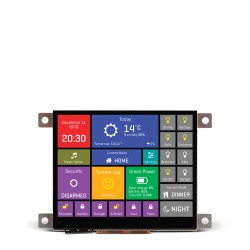Back in February of 2015, MikroElektronika started supporting a new architecture of microcontrollers - the FT90x from FTDI. Although new in this endeavour, the FT90 proved itself to be a worthy microcontroller, running on 100 mHz by default, it is one of the faster architectures out there. One step back of this chip, however, is that it has very few peripheral buses - one SPI master, two I2C buses and two UARTs. Obviously, if you want to make a project in which the microcontroller will send and read data from many different peripherals, maybe FT90 is not the best solution for you. But, if you are concerned about speed, if you want your MCU to send data really fast, then look no further, because 0 - FT900 does exactly that!
When talking about CPU performance and how it plays out, somehow graphics always come in mind. Mainly because, to do them, the CPU requires a lot of power and resources. This is exactly why our new line of displays carries the FT900 microcontroller - meet the mikromedia HMI!
 Mikromedia HMI
Mikromedia HMI
"Undressing" the mikromedia
If you take a closer look at our new mikromedia line, you will notice a significant difference between the previous mikromedias - the HMI doesn't have any peripheral modules connected! As HMI stands for Human Machine Interface, the new mikromedia focuses exactly on this - interfacing the user with the machine, leaving the peripherals untouched.
 mikromedia HMI Schematic
mikromedia HMI Schematic
The PDF of the schematic can be found here. The FT900 MCU is connected to another great invention by FTDI - the FT812/813 graphics controller. The FT900 sends the initial commands to the FT812/13, which then drives the display. The FT900 is also connected to serial flash memory, for which we have provided a library which comes with the example for the mikromedia.
Two sides to every display
What is also new is that we officially have mikromedia that has a capacitive display! The Riverdi displays which are connected to the mikromedia board can be either resistive or capacitive. For those that don't need any type of touchscreen, we offer the HMI without a touchscreen option. Choose what fits your project best!
Let's get some code done!
Our Visual TFT software supports FT812/13 graphic controllers since the beginning of this year. This makes the development on the new mikromedia HMI much easier. When creating a new project, under general settings, choose the ft812 of ft813 graphic controller. Our VTFT software will auto generate all the drivers necessary to write to a display run with these graphic controllers.

As always, VTFT will generate a set of source files:
 Generated VTFT files
Generated VTFT files
After that, you are ready to develop the rest of your code! The main function will be generated as follows:
void main() {
InitVTFTStack();
while (1) {
ProcessVTFTStack();
}
}
Example
If you are still unsure how a project for the mikromedia HMI should look like, don't panic! One of the interns from our laboratory did examples for our new mikromedias you can find them on Libstock and GitHub. The examples also contain a documented library for the serial flash on the board.
 First screen of the example
First screen of the example
Programming the board
The board can be programmed in two ways: with an external programmer or using a bootloader. In the first case, the hardware engineers at MikroElektronika have provided an additional breakout board which eases the process of putting down the code on the metal. The board has a connector for mikroProg for FT90 on one end, and a serial cable connector on the other. Attach the mikroProg, and, on the other end, connect the board with the mikromedia using the flat cable. The cable should go in the "main" connector of the mikromedia. That's it! You are ready to program your board! The breakout board also has the routed peripheral pins, in case you want to connect a peripheral device to the board.
The mikromedia HMI also comes with a bootloader for FT900, that way, you can program the board through the USB port. Using the bootloader is explained here. If you have an external programmer, but still want to upload the bootloader on your mikromedia, you can download the hex file here.
 Externally programming the MikroMedia board
Externally programming the MikroMedia board
The Future
The new mikromedias bring a lot of new possibilities to the table. And generating project is now as easy as can be with the Visual TFT supporting these graphic controllers. We are keen to see what you, our customers, will develop in the time coming! Share your projects with us on Libstock, and if you need any help, feel free to contact our support team! Good luck!
References
Touch Screen, Wikipedia 2016
Human Machine Interface, Wikipedia 2016
Riverdi Displays, 2016
Libstock, 2016














